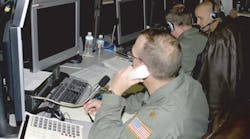By John Keller, chief editor
Military & Aerospace Electronics
At this writing, a city bus driver from Maryland is dead, shot in the chest this morning from a high-powered rifle as he stood in the doorway of his bus. No one knows who killed him or why. We can only hope the police find his killer soon. The victim, Conrad Johnson, a 35-year-old father of two, is the 13th person shot in the last 20 days within a 100-mile radius of our nation's capital, all under similar circumstances — one shot, one victim, an assailant who vanishes like smoke. Ten of those shot are dead. Three victims survive.
This spree of sniper shootings has folks in Maryland, Virginia, and the District of Columbia ducking low as they gas-up their cars, walking in fast zig-zags as they head to the corner to mail a letter, curtailing school programs, and pulling their kids home out of soccer practice. Some people, no doubt, are scanning the Internet for good deals on bulletproof vests. In short, plenty of Americans are scared to walk into a restaurant or pull into a gas station; in fact, they're terrified. Isn't this precisely the goal of some very evil people, many of whom are headquartered in the Middle East?
I don't know if the Washington-area shooter — or shooters — is connected to al-Qaida or not. At the end of the day, it doesn't really matter. The fact is, if this shooter isn't working for some radical Islamist terror network, he's conducting a clinic for those who are, in how to instill terror in the residents of major American cities — one shot at a time. The shooter's allegiances are not of prime importance, but the results of this killer's crime spree are.
If this isn't a homeland security threat, I don't know what is.
Thankfully, some of the experts are getting involved, but not quickly enough. Officials of the U.S. Department of Defense have been approached about using unmanned aerial vehicles for wide-area surveillance in efforts to catch the killer, whom members of the media have dubbed "The Serial Sniper." This is a step in the right direction, because those trying to catch this criminal should dip into whatever technological resources they have available.
What worries me, however, is that not enough experts are taking this case for what it is — a homeland security threat every bit as formidable as airliners flown into skyscrapers. It doesn't matter whether or not the perpetrator, or perpetrators, has an Arab surname. This has all the earmarks of a broad assault on our homeland security: several different states and jurisdictions involved, threats to commerce, transportation, and individual liberties, and a personally unknown and sophisticated adversary. But most important, these incidents have a substantial segment of the public fearing for their lives.
No matter what the shooter's name is, or whom he's working for, he is at the center of the new United States war on domestic terrorism. Although he may not be a professed terrorist himself, his actions are achieving the same ends, and may represent a warm-up for even more sinister domestic terror attacks in the future.
This shooting spree in the Washington, D.C., area underscores the dire need to improve domestic security measures, technologies, and administration in our nation. If law enforcement leaders have not yet awakened to this fact, I think they will soon.
The fundamental underlying premise of homeland security is simple; it means we're all in this fight together against a common terrorist enemy. This is a new kind of war that cries out for new tactics, technologies, and organizations. This is an adversary like Americans have rarely faced before — faceless and often nationless, but with a common purpose: to paralyze American culture, commerce, and institutions.
In this kind of war, the enemy's nationality, ethnic heritage, or political loyalty matter far less than do the results of his actions, and it is these results that identify the enemy. In short, a terrorist is a terrorist, whether he's a hijacker, kidnapper, serial killer, or computer hacker, and we as Americans must have the procedures, administration, and technology in place to identify the enemy quickly and confront him at our earliest opportunity.
Given the example of the Washington-area sniper, this means the case doesn't belong to only one police department or another, or just to city or state law-enforcement authorities. For starters, the FBI should get intimately involved in this case, and fast. Even so, that doesn't mean it should be solely an FBI show. We're all in this together — city police, county sheriff's deputies, state troopers, FBI agents, as well as active-duty and reserve military personnel.
It doesn't stop there. A terrorist attack on one American is an attack on all Americans. We're supposed to learn this in elementary school in those lessons about closing ranks on bullies. This war involves us all. The technology industry has a big role in developing surveillance and terrorist-response systems. Colleges and universities have a role in researching technologies and procedures to fight terrorism of the future. And every American has a role in keeping his or her eyes open in our workplaces and in our neighborhoods.
We have a lot of work to do where homeland security is concerned, and not a lot of time to do it. We have to improve how we identify the enemy. Next we have to improve how we go after the enemy once we've identified him. Then we have to come up with the best ways of watching out for the enemy, and of responding when the enemy strikes. Military and aerospace electronics technology will play a huge role in these endeavors, but technology is only one part to the puzzle.
The first step is to look around at what we need to protect. That means taking a long look at our families, our friends, and our colleagues. We're all in this together, and the sooner we acknowledge that, the sooner we'll all be able to craft a homeland security plan that has a chance of keeping us all safe.
Let's go to work.
GEIA: defense electronics spending to rise over next decade
by John Rhea
TYSONS CORNER, Va. — In the midst of the heightened awareness of defense needs driven by the current drive toward shoring up homeland security, analysts at this year's Government Electronics and Information Technology Association (GEIA) conference offered an optimistic scenario for defense spending over the next decade, but they also cautioned attendees about the cyclical nature of the business.
Cecil Black, manager of market analysis for the Boeing Co. in Arlington, Va., in his top line defense budget analysis, said the current fiscal year defense budget would reach $390 billion. This still has to be voted on in a lame duck congressional session since Congress was unable to complete appropriations legislation before the Nov. 5 election. The number also includes an anticipated supplemental U.S. Department of Defense budget request that Black expected to be submitted early next year.
As of the Oct. 29-31 GEIA meeting, Congress had still not completed the appropriations bills, and
the federal government was operating under what are known as "continuing resolutions" ("continuing irresolutions," one speaker noted) that permits agencies to continue spending at the rate of the previous fiscal year ended Sept. 30.
The top-line defense budget is projected to grow to $434 billion — all numbers in constant 2003 dollars and representing budget authority rather than actual expenditures — but Black stressed the cyclical nature of this business. The growth will be 1.8 percent annually during the early part of the decade-long projection out to 2013, but will taper off to 1.1 percent later on.
The electronics content, over the same decade, will rise from $74 billion to $87 billion. This typically falls in three categories, and the electronics content for each is as follows: from $13 billion up to $16 billion for operations and maintenance; $32 billion down to $29 billion for research, development, test, and evaluation (RDT&E); and from $29 billion up to $41 billion for procurement.
This scenario assumes no major changes, and Black noted that full-scale military intervention at the level of the 1990-91 Persian Gulf War could drive up defense spending by as much as $43 billion.
Homeland security issues also may change these projections. "Another 9-11 incident would essentially reset the clock."
Although he noted that the top-level RDT&E request is the highest in history, he also cautioned that the procurement number falls far short of previous years when measured in constant dollars. The anticipated $73 billion for 2003 is only half of the $144 billion earmarked for total procurement in 1992, he said.
The nature of the electronics content is also changing, Black says. Procurement of weapons platforms, such as aircraft, ships, and ground vehicles, has been steadily declining. He listed the two opportunities for the electronics industry in the new climate as information technology and command, control, communications, intelligence, surveillance, and reconnaissance.
Echoing this cyclical theme was Heidi Wood, executive director of New York-based Morgan Stanley Dean Witter & Co., who stressed that investors now regard defense and aerospace as a mature industry. She looked back more than 20 years to compare what she calls the current "run up of the past two years" to a previous cycle that started from the bottom in 1974, peaked in 1985, and then hit bottom again in 1997.
The aerospace industry outperformed the Standard and Poor index during the 1974-1985 period, Wood said, but "then fell like a stone." She cautioned that companies in this industry should seek diversification to leverage their capabilities outside defense wherever possible. She singled out information technology as a particularly attractive opportunity.


